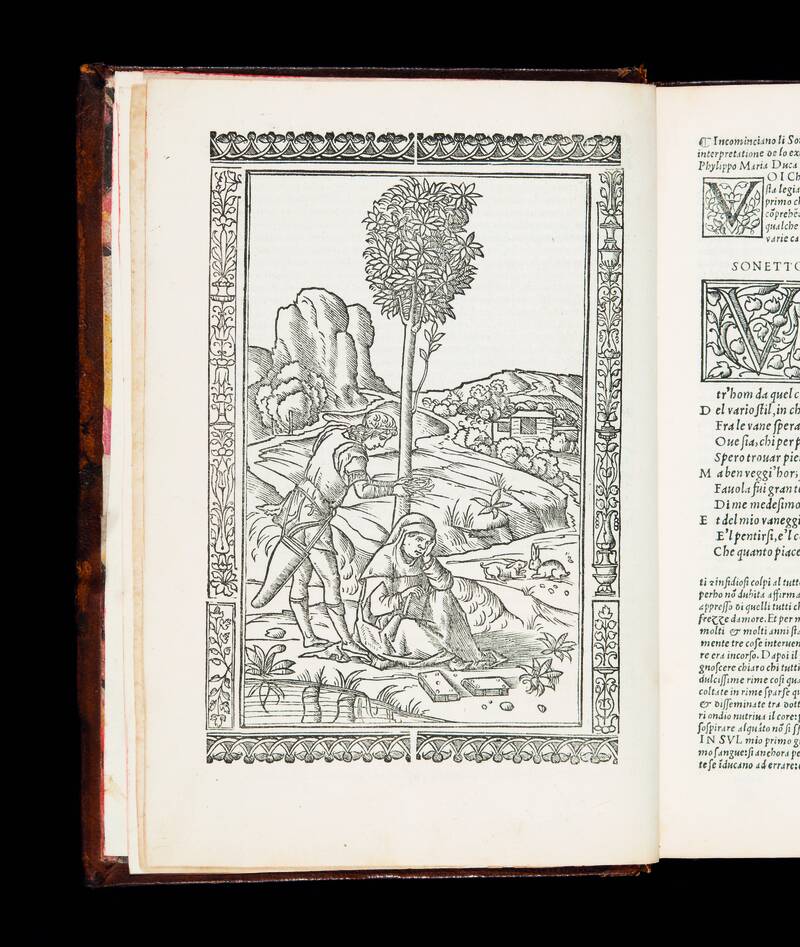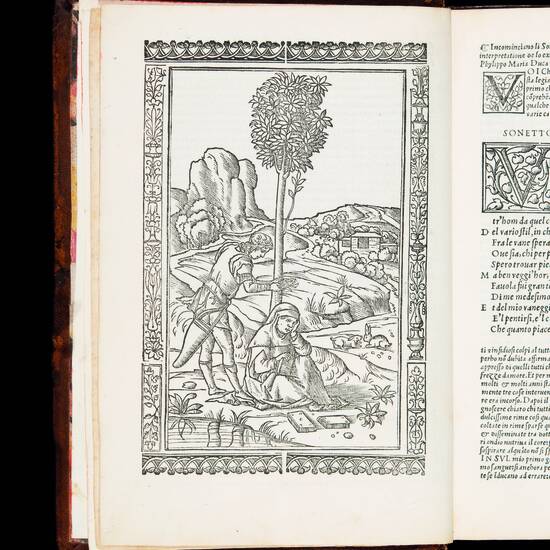PETRARCA, Francesco.. Li Sonetti canzone e triumphi del Petrarcha con li soi commenti non senza grandissima euigilantia et summa diligentia correpti et in la loro primaria integrita et origine restituti nouiter in littera cursiua studiossimamente impressi.
Venice: Bernardino Stagnino, 1513., BERNARDINO STAGNINO., 1513Two parts in one volume, quarto (209 x 131 mm.), 156, [8], 184 leaves with 7 full page woocuts, decorative initials. A restored tear on title page and two on the last page, a few spots but a very good copy bound in early XVIII century calf, spine in compartments with red morocco lettering piece, covers with gilt coat of arms.
Rare edition of Stagnino's publication of Petrarch's sonnets and triumphs. Two parts in one volume. The first half of the work includes a short biography by Antonio da Tempo and a woodcut illustration of Petrarch being crowned with a laurel wreath; the work's main body contains Petrarch's canzone and 316 sonnets with commentary by Francesco Filelfo and Girolamo Squarciafico. The second part of the volume is dedicated to the triumphs with commentary by Bernardo Lapini, with each of the six chapters opening with a woodcut illustration related to its theme: The Triumph of Chastity; of Death; of Love; of Fame; of Time; of Divinity. A total of seven full-page woodcut illustrations with beautifully clean line work. Marsand has described the present edition as “reproduced almost in full conformity with that of the famous edition made in Padua in the year 1472, having been copied from a manuscript by the poet himself. Even as regards to the typography, it cannot be denied that much diligence and accuracy was used. Beautiful exemplar” (Marsand, p.32)
Francesco Petrarca (1304- 1374) was one of the first to significantly solidify sonnet structure, where it works in conjunction with the rhyme scheme to emphasize the ideas of nehind the poem. “The sonnet was not his creation, but it became his creature” (Spiller, p. 45), moulded to sing the praises of his unrequited love for a woman, Laura, written both during her life and after her death. The love motif prevails in the collection of poems, but political, patriotic and moral feelings dominate some of them. The latter motif overflows heavily into the second part of the work, written in terza rima and making large use of allegory. In the Trionfi we have a victorious procession in which there take part six leading allegorical figures: Love, Chastity, Death, Fame, Time, and Divinity. Chastity triumphs over its predecessor until finally Divinity reigns supreme as the symbol of peace and eternal love. The Rime of Petrarch is not only one of the most influential, but also one of the most complicated of European lyric achievements - more than eight hundred critical works on the subject have been published in the twentieth century alone.” (Spiller, p. 45)
USTC 847803; Adams v.2 p.65 789; BM STC Italian p.503 C.57. C.24; Marsand, Biblioteca Petrarchesca pp.31-32; Not in Brunet; Spiller. The development of the sonnet: An introduction. 1992.

